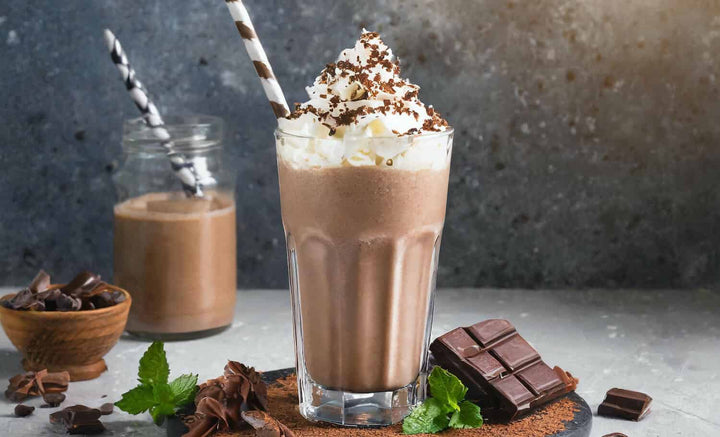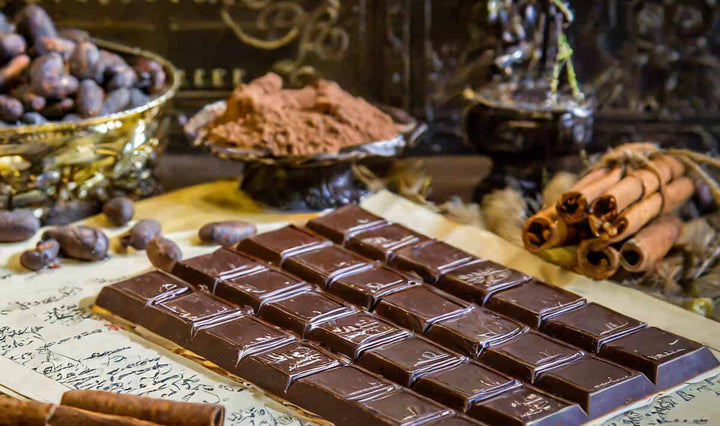As Valentine's Day approaches, the sweet scent of romance is often accompanied by chocolate's rich, indulgent aroma.
This beloved day of love marks a high point in chocolate sales as countless hearts seek to express affection through these delectable treats.
From artisanal truffles to heart-shaped chocolate boxes, we explore how this simple confectionery has become a symbol of romance and affection and why so many choose to say 'I love you' with the gift of chocolate.
How Much Chocolate is Sold on Valentine's Day in the UK?
On Valentine's Day in the UK, the sale of chocolate experiences a significant surge, reflecting its status as a popular gift choice for this romantic occasion.
While precise figures can vary yearly, millions of pounds are estimated to be spent on chocolate during the Valentine's period.
In recent years, data suggests that the UK has seen a substantial increase in chocolate sales in the weeks leading up to Valentine's Day.
This includes many products, from luxury chocolate boxes and artisanal creations to more affordable and widely accessible chocolate treats.
Factors influencing this trend include marketing campaigns by chocolate brands, the traditional association of chocolate with romance, and the convenience of chocolate as a gift.
Additionally, the emergence of more diverse and premium chocolate offerings has catered to a broader range of tastes and preferences, further driving sales.
The sales figures are not just indicative of the commercial aspect of Valentine's Day but also highlight the cultural importance of chocolate in the UK as a symbol of love and affection.

Why Give Chocolate on Valentine's Day?
Giving chocolate on Valentine's Day has become a deeply ingrained tradition, particularly embraced for its symbolic meanings and cultural significance.
The reasons for its popularity as Valentine's gift are multifaceted:
-
Symbol of Love and Affection: Chocolate has long been associated with romance and affection. This is partly due to its rich, indulgent nature, which makes it a luxurious and sensual gift.
-
Historical Associations: The connection between chocolate and love dates back to the Aztecs, who considered chocolate a source of strength and aphrodisiac properties.
-
Chemical Influence: Scientifically, chocolate contains compounds like phenylethylamine and serotonin, which evoke feelings of happiness and well-being.
-
Marketing and Commercialization: The role of marketing cannot be understated in the popularization of chocolate for Valentine's Day. Since the early 20th century, confectionery companies have heavily promoted chocolate as an ideal Valentine’s gift, further entrenching it in the holiday's traditions.
-
Versatility and Appeal: Chocolate's wide appeal also plays a significant role. Its versatility allows various products suitable for different tastes and budgets, from simple chocolate bars to elaborate, artisanal creations.
-
Cultural Tradition: Giving chocolate on Valentine's Day has become a cultural tradition. It's a familiar and expected practice, making it a safe yet cherished choice for many celebrating the day.
When Does Valentine's Day Chocolate Go on Sale?
In the UK, Valentine's Day chocolate typically starts appearing on shelves and in stores soon after the New Year celebrations, with the majority becoming available in late January.
This early arrival allows retailers to maximize the period leading up to Valentine's Day, which falls on February 14th.
High street shops, supermarkets, and confectioners begin their Valentine's promotions early to capture consumers' attention.
This is also when online retailers showcase their Valentine’s Day specials, often with options ranging from luxury chocolates to more affordable treats.
As Valentine’s Day nears, you'll notice an increase in the range and visibility of chocolate products specifically marketed for the occasion.
These can include heart-shaped boxes, chocolates with romantic messages, and limited-edition flavours.
Furthermore, some retailers might offer special deals or discounts as Valentine's Day approaches, particularly in the first week of February.
These sales strategies are aimed at both early-bird shoppers and last-minute buyers.
It's worth noting that while most Valentine's Day chocolate goes on sale well before the holiday, there are often post-Valentine's Day sales, where the remaining stock is sold at reduced prices.
These sales usually start on February 15th and continue while supplies last.
How Much Chocolate is Consumed on Valentine's Day in the UK?
On Valentine's Day in the UK, the consumption of chocolate sees a remarkable increase, reflecting its status as a quintessential gift and treat for the occasion.
While exact figures can fluctuate annually, it's clear that a significant portion of the population indulges in chocolate during this romantic holiday.
Estimates suggest that millions of pounds worth of chocolate are sold in the run-up to Valentine's Day, indicating a high level of consumption.
This encompasses a wide array of chocolate products, from luxury boxes of assorted chocolates to more accessible chocolate bars and heart-shaped confections.
The reasons for this surge are multifaceted.
Chocolate's association with romance, its role as a traditional gift, and extensive marketing campaigns all contribute to its popularity.

What is the History of Valentine’s Day?
The history of Valentine's Day is a fascinating blend of ancient traditions, romantic legends, and evolving cultural practices.
This celebration of love and affection, observed on February 14th, has roots that can be traced back to both Christian and ancient Roman traditions.
-
Ancient Roman Origins: The festival of Lupercalia, celebrated in mid-February in ancient Rome, is often linked to the origins of Valentine's Day. Lupercalia was a fertility festival dedicated to Faunus, the Roman god of agriculture, and to the Roman founders Romulus and Remus. It involved rituals that were believed to ward off evil spirits and purify the city, releasing health and fertility.
-
Saint Valentine(s): The day gets its name from Saint Valentine, but there's a bit of mystery here as the Catholic Church recognises at least three different saints named Valentine or Valentinus, all of whom were martyred. One legend contends that Valentine was a priest who served during the third century in Rome. When Emperor Claudius II decided that single men made better soldiers than those with wives and families, he outlawed marriage for young men. Valentine, realising the injustice of the decree, defied Claudius and continued to perform marriages for young lovers in secret. When his actions were discovered, Claudius ordered that he be put to death.
-
Chaucer and the Romantic Connection: The romantic nature of Valentine's Day may have been solidified by Geoffrey Chaucer, the English poet of the Middle Ages. In the 14th century, Chaucer wrote poetry about love and courtship, associating Valentine’s Day with romantic love. This was a period when courtly love flourished, and pairing the day with romance seemed fitting.
-
Evolution in the Modern Era: Valentine's Day had become firmly associated with love in the UK and Europe by the Middle Ages. Handmade paper cards became the tokens-du-jour in the Middle Ages, and by the 18th century, this practice had become widespread among all social classes. In the 19th century, with advancements in printing technology, mass-produced Valentine's cards began to appear.
-
Global Spread and Commercialisation: In the 20th century, Valentine's Day evolved into an occasion where lovers expressed their love for each other by presenting flowers, offering confectionery, and sending greeting cards (known as "Valentines"). The commercialisation of Valentine's Day in the United States and UK occurred in the late 19th and early 20th centuries and gradually spread to other parts of the world.
Valentine’s Day has transitioned from a pagan festival to a day celebrating romantic love, marked by exchanging cards, gifts, and gestures.
Where Can You Buy Tasty Chocolate?
Whitakers Chocolates, renowned for our long history in crafting delicious and affordable chocolates, offers a range of options suitable for everyone, including vegetarian, vegan, and gluten-free choices.
Our top-selling products, such as indulgent Coffee Creams, Neapolitans, Chocolate Wafer Thins, Stem Ginger and Luxury Chocolate Truffles, are perfect for enhancing your mocha coffee experience.
Click here to see our full range of delicious chocolates…
Some Notes From an Expert Chocolatier
As an expert chocolatier, it's heartwarming to witness how chocolate has become a universal language of love and affection, particularly on Valentine's Day.
Crafting these confections is not just about creating something sweet; it's about being a part of countless love stories.
Each chocolate piece, from the creamy truffles to the rich, velvety bars, is a testament to the time-honoured tradition of expressing romantic love through taste.
The joy in this craft lies in knowing that with every carefully crafted piece, we're providing a means for people to convey their deepest sentiments, creating moments of connection and sweetness beyond words.
Final Notes On Chocolate and Valentine’s Day
The bond between chocolate and Valentine's Day is more than just a commercial trend; it's a rich tapestry woven into the fabric of how we express love and affection.
This time-honoured tradition transcends mere gifting; it is a sensory experience that symbolises warmth, indulgence, and the sweetness of romantic connections.
As each year passes, the role of chocolate in Valentine's Day celebrations continues to evolve, yet its essence remains the same – a universally understood symbol of affection and care.
Whether it's a simple bar of artisan chocolate or an elaborate box of assorted truffles, the act of giving chocolate on Valentine's Day resonates with a deep understanding that, sometimes, emotions are best conveyed through the timeless language of taste and indulgence.











